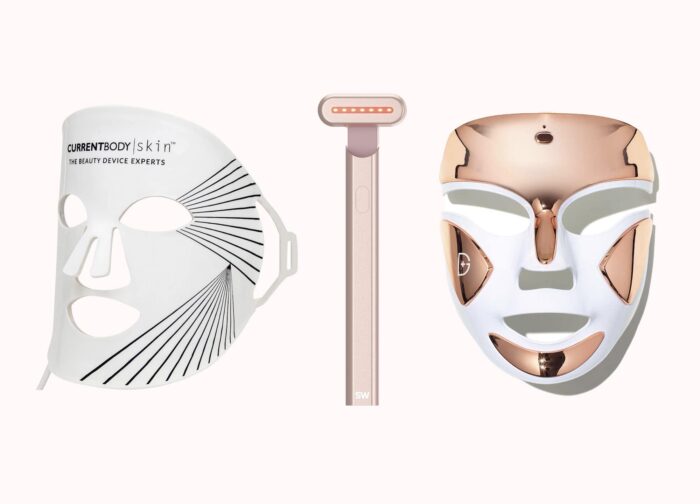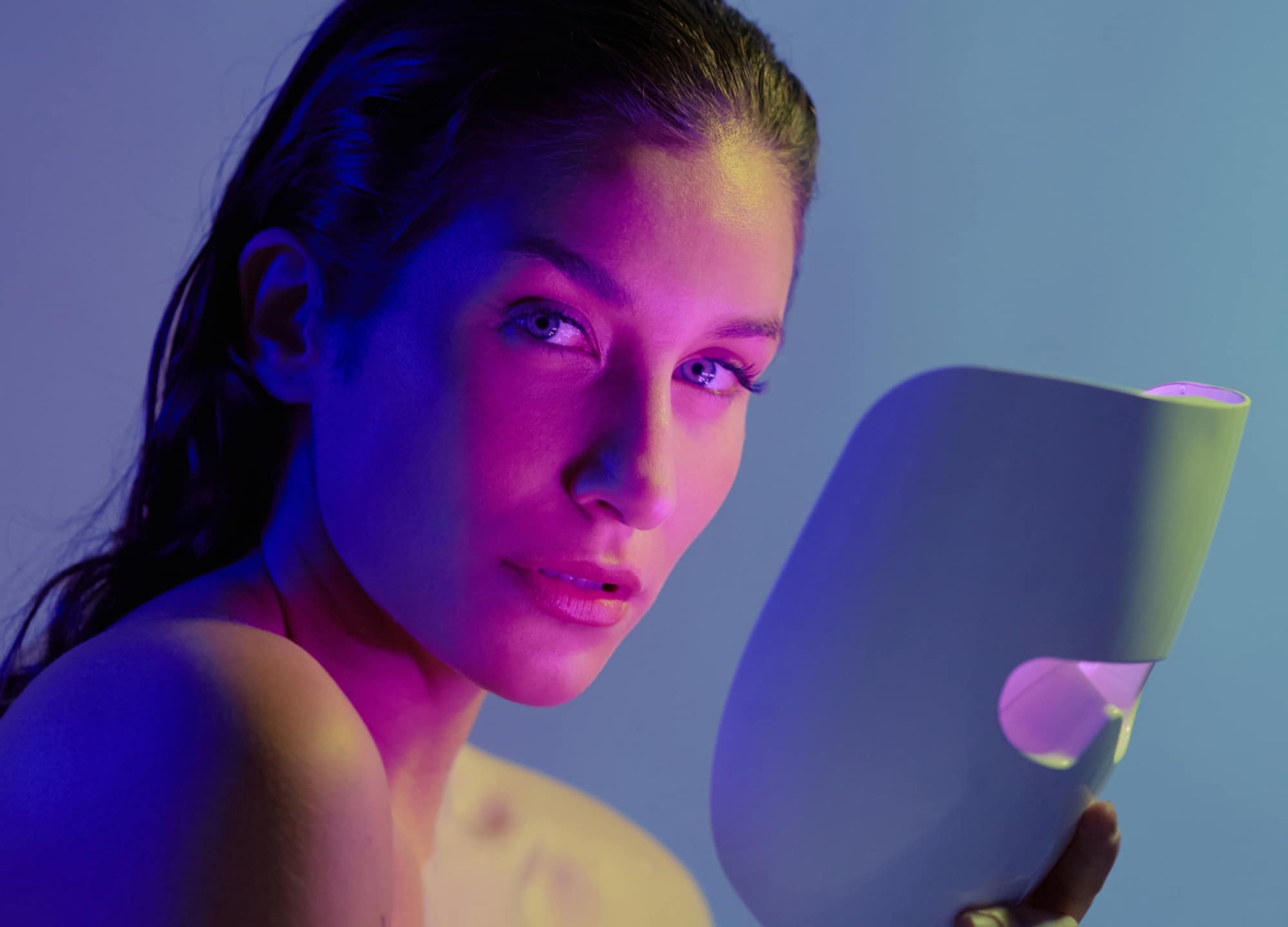There are very few (if any) skin-care treatments that come with absolutely no side effects or downtime, are safe for all skin tones, and *actually* deliver results. One category that somehow manages to check all of those boxes? LED light therapy. “LED stands for light emitting diodes, which emit different wavelengths of visible light. That light energy is then absorbed by the skin and changes the biological activity of the cells,” explains Dr. Howard Sobel, a board-certified dermatologist in New York City. Fun fact: LED skin phototherapy treatments were first developed and used by NASA in the 1990s, to help promote wound healing for astronauts, he adds. Different wavelengths affect the skin differently, ultimately resulting in different types of effects.
And while it may seem hard to believe that something truly noninvasive and, for all intents and purposes, completely benign can yield real results, doctors say it’s possible—however, that’s only if a few key criteria are met.
1) The most effective LED light treatments utilize red and/or blue light
LED light comes in a rainbow of colors, but all the experts we spoke with agree that red and/or blue LED treatments are the way to go. These colors are the most utilized, studied, and effective, explains Dr. Kiran Mian, a board-certified dermatologist in New York City. Red light has a wavelength of 620–750 nm (nanometers), while blue light has a shorter wavelength of 400–495 nm. “This means that red light penetrates deeper into the skin, where it increases collagen production, helps repair damage, and decreases cytokines that cause inflammation,” she explains. It’s ideal for those looking for anti-aging effects—combating fine lines and wrinkles and boosting elasticity—as well as redness minimization. (It’s why LED light treatment for rosacea is a thing.)
Blue light, on the other hand, works slightly more superficially. It kills the bacteria that’s associated with acne, P. acnes, says Dr. Mian. It also targets the sebaceous glands, reducing oil, and as such, this type of LED acne treatment is a great option for those with oily or blemish-prone skin, adds Dr. Sobel.
2) In-office LED facial treatments will always be superior to at-home ones
As is the case when comparing professional and at-home devices of any kind, the latter are simply never going to be as powerful (read: as effective) as the former. An at-home LED light treatment simply isn’t built to deliver the same amount of energy as you can get with a professional treatment—not to mention that brands need to account for the fact that user error among consumers is always possible, Dr. Sobel points out. These companies know that there is always going to be someone who doesn’t read the instructions and uses the device for hours on end or shines it into their eyes, adds Dr. Konstantin Vasyukevich, a board-certified facial plastic surgeon in New York City. And yes, while LED light is overall safe, any type of medical treatment has the potential for harm if used excessively or incorrectly, he says. (In related news, both in-office and at-home LED treatments are contraindicated for clients with compromised skin—i.e., if you have open sores or a rash—as the energy will affect the skin differently and the results are much less predictable, says Dr. Mian. They’re also typically not recommended for women who are pregnant, as there simply isn’t enough research to confirm that they’re safe for both mom and baby.)
All that being said, “This doesn’t mean that the at-home ones don’t work. The question simply is whether they work enough to yield a noticeable difference,” says Dr. Sobel. And here’s where details matter. Not all over-the-counter devices are created equal; a quick Google search yields a dizzying array of options, ranging in price from less than 50 dollars to hundreds of dollars. To that point…
3) Check the specifics on any at-home LED facial treatment
If you do want to pick up a DIY tool, do your research. Broadly speaking, you will get what you pay for, says Dr. Mian. (In other words, yes, you probably will be shelling out the big bucks.) But there are still a few key things to look for. First, make sure the wavelengths are disclosed for any LED light skin treatment. While both red and blue light fall within a range, the “sweet spot” for red light is 633 nm, while 400–470 nm is ideal for blue light; these are the specific wavelengths that have been studied to have the best effects, she explains. For example, the Dr. Dennis Gross DRx SpectraLite FaceWare Pro ($455) lists its red light at 630–700 nm and blue light at 400–470 nm.

Next, check to see if the total energy, measured in milliwatts, is listed. “A good LED treatment will deliver anywhere between 40 and 100 milliwatts,” says Dr. Mian, although that range is mostly found among in-office options; at-home ones typically come in at slightly less than or at the lower end of that range. Take the CurrentBody Skin LED Light Therapy Face Mask ($380), which delivers 30 milliwatts, or the Solawave 4-in-1 Radiant Renewal Skincare Wand ($169), which packs 40–45 milliwatts. It’s also helpful to choose devices that have been clinically studied—the results of which you can find with a quick Google search—as well as those that have before and after photos on their websites, adds Dr. Sobel. Regardless, LED light should never feel hot on your skin. If the device heats up, that’s a red flag and you should discontinue use, particularly if you’re prone to melasma, which can be exacerbated by heat, Dr. Mian cautions.
4) LED light skin treatments are best used as an adjunct to your routine
While all the doctors we spoke with say LED treatments do have the potential to deliver real results, they’re still best utilized as an add-on to the rest of your skin-care/cosmetic-treatment protocol. “LED therapy is good for maintaining the condition of the skin, a key component of overall facial rejuvenation, but because it is fairly mild, there is still a role for other things such as lasers, peels, microneedling, and injectables,” says Dr. Vasyukevich. FYI, this holds true for both in-office treatments and their at-home counterparts. Both Dr. Mian and Dr. Sobel note that they most often utilize in-office LED light treatment facials in tandem with other treatments, for example, after one of the aforementioned options, like a laser or peel.
And if you’re using an at-home device, it certainly isn’t a direct substitute for tried-and-true topicals—think retinoids, alpha hydroxy acids, and the like. “LED therapy can’t be your only ‘source’ of skin care. It’s better to think of it as an add-on to the other things you’re already doing,” Dr. Mian notes.
5) Consistency and patience are key
Even then, don’t expect a quick fix. Both professional and DIY LED face treatments need to be performed regularly, and it will take time to see results. Exactly how long depends largely on the device and the condition of your skin, but as a general rule of thumb, this is something you need to do at least three times per week for six weeks before you’ll start to see a difference, says Dr. Mian. (Though she does note that the effects of blue light may show up slightly sooner than red, at about the four-week point.) As for the at-home devices, this is why it’s also important to choose one that is comfortable and easy to use and incorporate into your daily routine. “If you don’t have 15 minutes to lie down and keep your eyes closed, you’re better off choosing one that you can wear while you multitask,” Dr. Mian advises.











